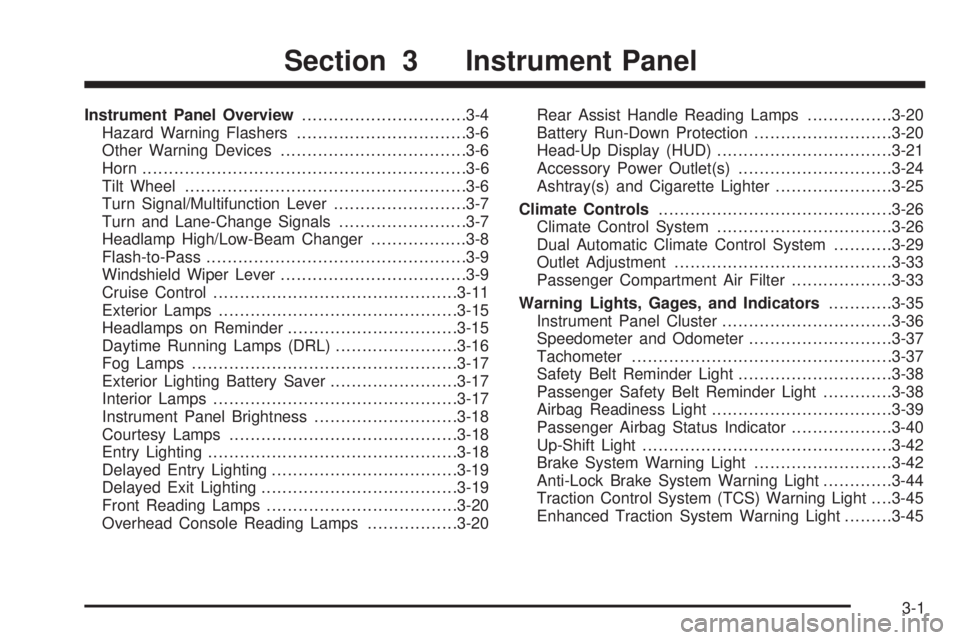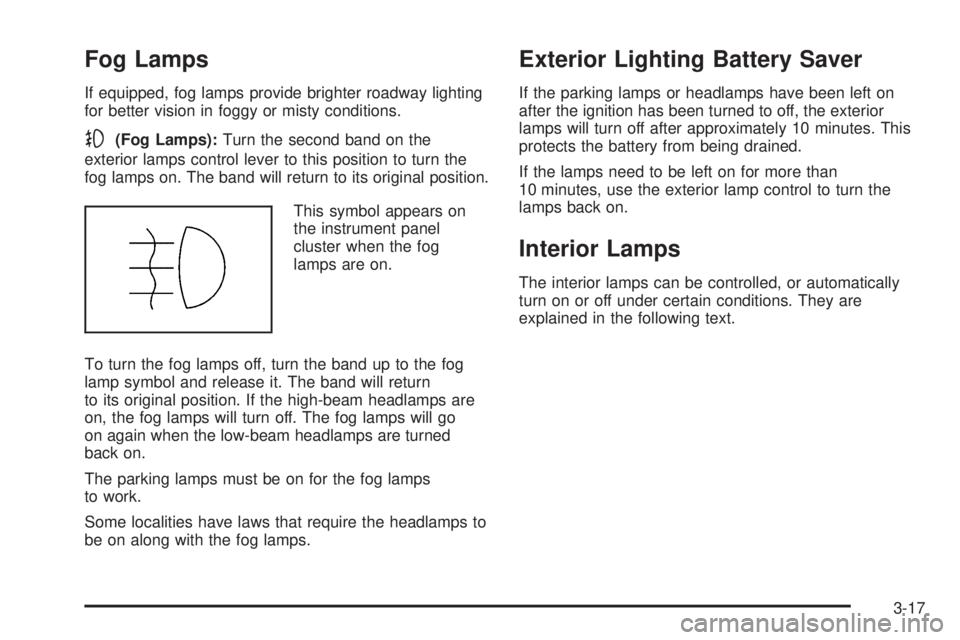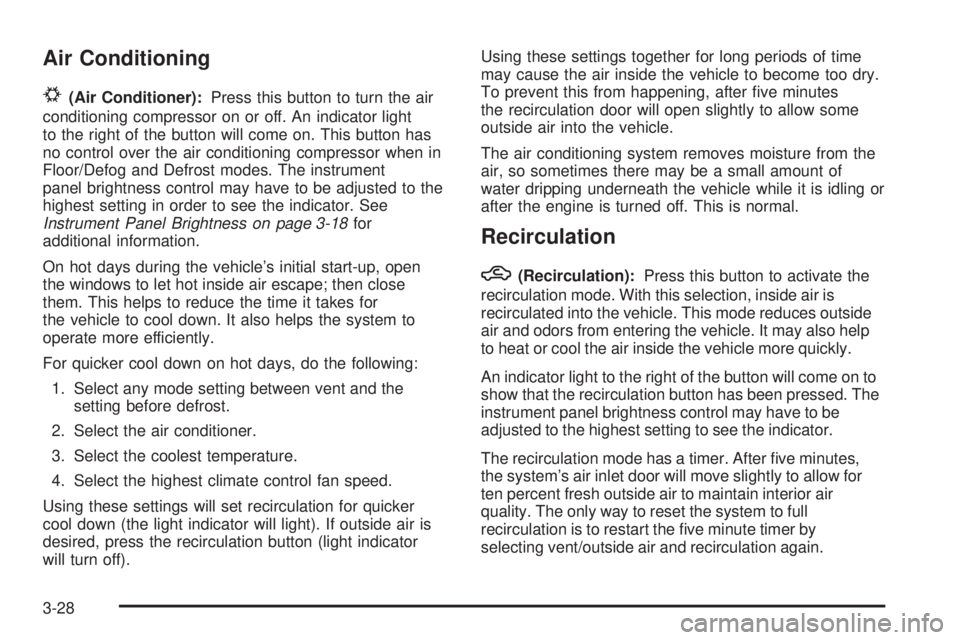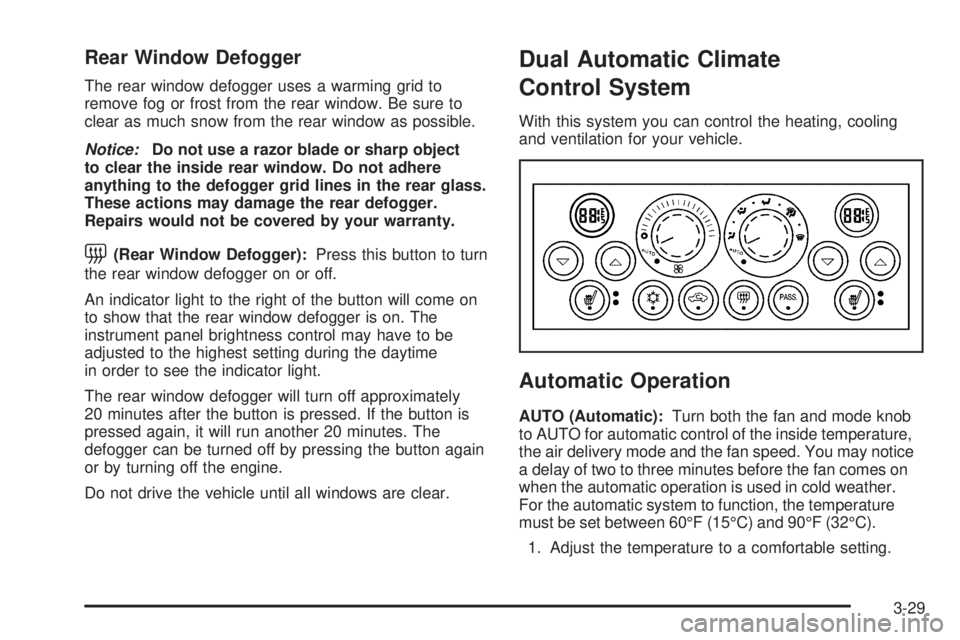2006 PONTIAC GRAND PRIX fog light
[x] Cancel search: fog lightPage 119 of 472

Instrument Panel Overview...............................3-4
Hazard Warning Flashers................................3-6
Other Warning Devices...................................3-6
Horn.............................................................3-6
Tilt Wheel.....................................................3-6
Turn Signal/Multifunction Lever.........................3-7
Turn and Lane-Change Signals........................3-7
Headlamp High/Low-Beam Changer..................3-8
Flash-to-Pass.................................................3-9
Windshield Wiper Lever...................................3-9
Cruise Control..............................................3-11
Exterior Lamps.............................................3-15
Headlamps on Reminder................................3-15
Daytime Running Lamps (DRL).......................3-16
Fog Lamps..................................................3-17
Exterior Lighting Battery Saver........................3-17
Interior Lamps..............................................3-17
Instrument Panel Brightness...........................3-18
Courtesy Lamps...........................................3-18
Entry Lighting...............................................3-18
Delayed Entry Lighting...................................3-19
Delayed Exit Lighting.....................................3-19
Front Reading Lamps....................................3-20
Overhead Console Reading Lamps.................3-20Rear Assist Handle Reading Lamps................3-20
Battery Run-Down Protection..........................3-20
Head-Up Display (HUD).................................3-21
Accessory Power Outlet(s).............................3-24
Ashtray(s) and Cigarette Lighter......................3-25
Climate Controls............................................3-26
Climate Control System.................................3-26
Dual Automatic Climate Control System...........3-29
Outlet Adjustment.........................................3-33
Passenger Compartment Air Filter...................3-33
Warning Lights, Gages, and Indicators............3-35
Instrument Panel Cluster................................3-36
Speedometer and Odometer...........................3-37
Tachometer.................................................3-37
Safety Belt Reminder Light.............................3-38
Passenger Safety Belt Reminder Light.............3-38
Airbag Readiness Light..................................3-39
Passenger Airbag Status Indicator...................3-40
Up-Shift Light...............................................3-42
Brake System Warning Light..........................3-42
Anti-Lock Brake System Warning Light.............3-44
Traction Control System (TCS) Warning Light. . . .3-45
Enhanced Traction System Warning Light.........3-45
Section 3 Instrument Panel
3-1
Page 120 of 472

Engine Coolant Temperature Warning Light......3-46
Engine Coolant Temperature Gage..................3-46
Malfunction Indicator Lamp.............................3-47
Oil Pressure Light.........................................3-50
Fog Lamp Light............................................3-50
Cruise Control Light......................................3-51
Highbeam On Light.......................................3-51
Fuel Gage...................................................3-51
Driver Information Center (DIC).......................3-52
DIC Controls and Displays (Base Level DIC). . . .3-52
DIC Controls and Displays (Uplevel DIC
with Trip Computer)...................................3-60
DIC Warnings and Messages.........................3-72Audio System(s).............................................3-94
Setting the Time...........................................3-96
Radio with CD (Base Level)...........................3-96
Radio with CD (MP3)..................................3-107
Radio with Six-Disc CD................................3-123
Navigation/Radio System..............................3-139
Theft-Deterrent Feature................................3-139
Audio Steering Wheel Controls......................3-139
Radio Reception.........................................3-140
Care of Your CDs.......................................3-141
Care of the CD Player.................................3-141
Backglass Antenna......................................3-141
XM™ Satellite Radio Antenna System............3-142
Chime Level Adjustment...............................3-142
Section 3 Instrument Panel
3-2
Page 134 of 472

Daytime Running Lamps (DRL)
Daytime Running Lamps (DRL) can make it easier for
others to see the front of your vehicle during the
day. DRL can be helpful in many different driving
conditions, but they can be especially helpful in the short
periods after dawn and before sunset. Daytime running
lamps are required to function at all times on all
vehicles �rst sold in Canada.
A light sensor on top of the instrument panel makes the
DRL work, so be sure it is not covered.
The DRL system will make the low-beam headlamps
come on at reduced brightness when the following
conditions are met:
The ignition is on.
The exterior lamps control is off.
The parking brake is released.
While the DRL are on, only the vehicle’s low-beam
headlamps will be on at reduced brightness. The turn
signal, taillamps, sidemarker and other lamps will not be
on. The instrument panel cluster will not be lit up either.When it is dark enough outside, the DRL will turn off
and the vehicle’s headlamps and parking lamps will turn
on. The other lamps that come on with the headlamps
will also come on.
When it is bright enough outside, the headlamps will go
off and the DRL will come on.
To idle the vehicle with the DRL off, turn the exterior
lamp control off and then do one of the following:
Turn the exterior lamp control to the parking
lamp position.
Turn the exterior lamp control to the
headlamp position.
Turn the exterior lamp control from AUTO to off and
back to AUTO.
This feature is not available for vehicles �rst sold
in Canada.
To turn off the automatic headlamp feature when it is
dark outside, move the exterior lamp control to the
parking lamp position. The parking lamps will remain
illuminated and the headlamps will turn off. The
fog lamps will also go on if they were on previously.
As with any vehicle, the regular headlamp system
should be turned on when needed.
3-16
Page 135 of 472

Fog Lamps
If equipped, fog lamps provide brighter roadway lighting
for better vision in foggy or misty conditions.
-(Fog Lamps):Turn the second band on the
exterior lamps control lever to this position to turn the
fog lamps on. The band will return to its original position.
This symbol appears on
the instrument panel
cluster when the fog
lamps are on.
To turn the fog lamps off, turn the band up to the fog
lamp symbol and release it. The band will return
to its original position. If the high-beam headlamps are
on, the fog lamps will turn off. The fog lamps will go
on again when the low-beam headlamps are turned
back on.
The parking lamps must be on for the fog lamps
to work.
Some localities have laws that require the headlamps to
be on along with the fog lamps.
Exterior Lighting Battery Saver
If the parking lamps or headlamps have been left on
after the ignition has been turned to off, the exterior
lamps will turn off after approximately 10 minutes. This
protects the battery from being drained.
If the lamps need to be left on for more than
10 minutes, use the exterior lamp control to turn the
lamps back on.
Interior Lamps
The interior lamps can be controlled, or automatically
turn on or off under certain conditions. They are
explained in the following text.
3-17
Page 145 of 472

Recirculation cannot be selected when in this mode
even though the indicator light comes on when
the recirculation button is pressed.
The middle knob on the climate control panel can also
be used to select the defog or defrost mode.
Defogging and Defrosting
Fog on the inside of the vehicle is a result of high
humidity causing moisture to condense on the cool
window glass. This can be minimized if the climate
control system is used properly. There are two modes
to clear frost or fog from the windshield. Use the
defog mode to clear the windows of condensation and
to warm the vehicle’s occupants. Use the defrost
mode to remove frost or condensation from the
windshield quickly.
See “Rear Window Defogger” later in this section for
information on clearing the rear window of fog or ice.
.(Floor/Defog):Use the �oor/defog mode to clear the
windows of fog or moisture and to warm the passengers.
This mode directs the air equally between the
windshield and the �oor outlets, along with some
directed to the side window outlets.This mode will automatically use outside air. The air
conditioning compressor will be engaged unless
the outside temperature is 40°F (4°C) or below.
Recirculation cannot be selected when in this mode
even though the indicator light comes on when
the recirculation button is pressed.
1(Defrost):Use the defrost mode to remove fog or
frost from the windshield more quickly. This mode
directs most of the air to the windshield and the side
window outlets, with some air directed to the �oor
outlets. This mode has a timer and will shut off after
�ve minutes.
This mode will automatically use outside air. The air
conditioning compressor will be engaged unless
the outside temperature is 40°F (4°C) or below.
Recirculation cannot be selected when in this mode
even though the indicator light comes on when
the recirculation button is pressed.
Temperature
The knob on the right of the climate control panel is the
temperature adjustment that can be used with any of
the climate control modes.
Turn the knob clockwise for warmer settings and
counterclockwise for colder settings.
3-27
Page 146 of 472

Air Conditioning
#
(Air Conditioner):Press this button to turn the air
conditioning compressor on or off. An indicator light
to the right of the button will come on. This button has
no control over the air conditioning compressor when in
Floor/Defog and Defrost modes. The instrument
panel brightness control may have to be adjusted to the
highest setting in order to see the indicator. See
Instrument Panel Brightness on page 3-18for
additional information.
On hot days during the vehicle’s initial start-up, open
the windows to let hot inside air escape; then close
them. This helps to reduce the time it takes for
the vehicle to cool down. It also helps the system to
operate more efficiently.
For quicker cool down on hot days, do the following:
1. Select any mode setting between vent and the
setting before defrost.
2. Select the air conditioner.
3. Select the coolest temperature.
4. Select the highest climate control fan speed.
Using these settings will set recirculation for quicker
cool down (the light indicator will light). If outside air is
desired, press the recirculation button (light indicator
will turn off).Using these settings together for long periods of time
may cause the air inside the vehicle to become too dry.
To prevent this from happening, after �ve minutes
the recirculation door will open slightly to allow some
outside air into the vehicle.
The air conditioning system removes moisture from the
air, so sometimes there may be a small amount of
water dripping underneath the vehicle while it is idling or
after the engine is turned off. This is normal.
Recirculation
h
(Recirculation):Press this button to activate the
recirculation mode. With this selection, inside air is
recirculated into the vehicle. This mode reduces outside
air and odors from entering the vehicle. It may also help
to heat or cool the air inside the vehicle more quickly.
An indicator light to the right of the button will come on to
show that the recirculation button has been pressed. The
instrument panel brightness control may have to be
adjusted to the highest setting to see the indicator.
The recirculation mode has a timer. After �ve minutes,
the system’s air inlet door will move slightly to allow for
ten percent fresh outside air to maintain interior air
quality. The only way to reset the system to full
recirculation is to restart the �ve minute timer by
selecting vent/outside air and recirculation again.
3-28
Page 147 of 472

Rear Window Defogger
The rear window defogger uses a warming grid to
remove fog or frost from the rear window. Be sure to
clear as much snow from the rear window as possible.
Notice:Do not use a razor blade or sharp object
to clear the inside rear window. Do not adhere
anything to the defogger grid lines in the rear glass.
These actions may damage the rear defogger.
Repairs would not be covered by your warranty.
=(Rear Window Defogger):Press this button to turn
the rear window defogger on or off.
An indicator light to the right of the button will come on
to show that the rear window defogger is on. The
instrument panel brightness control may have to be
adjusted to the highest setting during the daytime
in order to see the indicator light.
The rear window defogger will turn off approximately
20 minutes after the button is pressed. If the button is
pressed again, it will run another 20 minutes. The
defogger can be turned off by pressing the button again
or by turning off the engine.
Do not drive the vehicle until all windows are clear.
Dual Automatic Climate
Control System
With this system you can control the heating, cooling
and ventilation for your vehicle.
Automatic Operation
AUTO (Automatic):Turn both the fan and mode knob
to AUTO for automatic control of the inside temperature,
the air delivery mode and the fan speed. You may notice
a delay of two to three minutes before the fan comes on
when the automatic operation is used in cold weather.
For the automatic system to function, the temperature
must be set between 60°F (15°C) and 90°F (32°C).
1. Adjust the temperature to a comfortable setting.
3-29
Page 149 of 472

9(Off):Turning the fan knob off will turn the
controller completely off. Only the rear window defogger
and heated seats will function when the fan knob is off.
Air Flow:This control has several settings to control
the direction of air�ow.
To change the current mode, select one of the following:
AUTO:This mode is automatically set depending on
the temperature in the vehicle and solar sensor
information.
H(Vent):This mode directs air to the instrument
panel outlets.
%(Bi-Level):This mode directs air�ow to the
instrument panel outlets and to the �oor outlets. A small
amount of air is also directed to the windshield and
the side window outlets.
6(Floor):This mode directs most of the air to the
�oor outlets with some air directed to the side window
outlets, and a little air directed to the windshield.
#(Air Conditioning):Press this button to turn
the air conditioning compressor on or off. The indicator
light on the button will come on when the air
conditioning is on.The indicator light on the air condition button will light
every time the vehicle is started. The air conditioner may
be turned off by pressing the air conditioner button.
?(Recirculation):Press this button to turn the
recirculation mode on or off. This mode keeps outside air
from coming in the vehicle. It can be used to prevent
outside air and odors from entering your vehicle or to help
cool the air inside your vehicle more quickly.
Recirculation is not available in defrost or �oor/defog
mode. Pressing the recirculation button will turn on the
indicator light.
Using recirculation for long periods of time may cause the
air inside your vehicle to become too dry. To prevent this
from happening, after the air in your vehicle has cooled,
turn the recirculation mode off.
z(Heated Seats):Press this button to turn the
heated seats on and off. The button on the left controls
the driver’s seat and the button on the right controls
the passenger’s seat. SeeHeated Seats on page 1-3for
additional information.
3-31